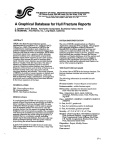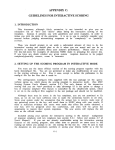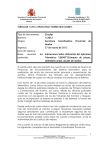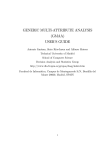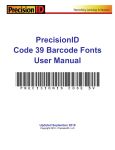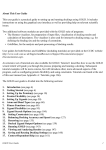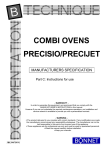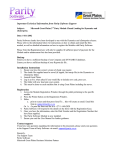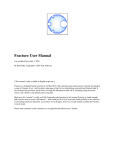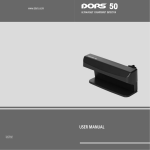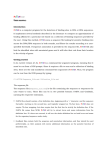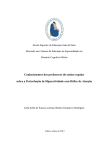Download M91-1038
Transcript
APPENDIX B : TEST PROCEDURE S 1. GENERAL INSTRUCTION S Testing may be done any time during the week of 6-12 May . The onl y requirement is that all reports (see section 4, below) be received by NOSC by firs t thing Monday morning, 13 May . Permission to attend MUC-3 at NOSC on 21-23 Ma y may be revoked if you do not meet this deadline ! To complete the required testing, you will need approximately the same amount o f time as it would normally take you to run 100 texts in DEV and interactively scor e them, plus some time to permit you to be extra careful doing the interactive scorin g (since the resulting history file is to be used for all passes through the scorin g program) and some time for the initializations of the scoring program with th e different configuration files required for the various linguistic phenomena tests . I f you carry out the optional testing, you will need to allow time to generate at least a couple new sets of response templates . In that case, you will also need time to add t o the history file as needed during the additional scoring runs . IF YOU INTEND TO CARRY OUT ANY OF THE OPTIONAL TESTING, YOU MUST REPORT THE PLANNED "PARAMETER SETTINGS" TO NOSC FOR BOTH THE REQUIRED TEST AND TH E OPTIONAL TESTING BEFORE STARTING THE TEST PROCEDURE. This means that you shoul d describe, in some meaningful terms, SPECIFICALLY how you will alter the behavio r of the system so that it will produce each of the different tradeoffs in metric s described in the sections below . 1 .1 REQUIRED TESTING : MAXIMIZED RECALL/PRECISION TRADEOF F To ensure comparability among the test results for all systems, THE REQUIRE D TESTING MUST BE CONDUCTED WITH THE SYSTEM SET TO MAXIMIZE THE TRADEOF F BETWEEN RECALL AND PRECISION IN THE MATCHED/MISSING ROW IN THE SCOR E SUMMARY REPORT . The maximum of recall and precision does not mean an ADDITIV E maximization, but that the total scores for each of the two metrics should be as clos e together and as high as possible . For most systems, this is probably the normal way the system operates . Several passes through the scoring program will be required, one for the officia l test on generating templates for the whole test set and the others for th e experimental tests on generating the specific slots called out by the linguisti c phenomena tests . You generate only one set of system responses, and only the firs t pass through the scoring program will require user interaction . The history fil e produced during this interaction will be used in the scoring of the linguisti c phenomena tests . (It will also serve as the basis for scoring any optional tests tha t are conducted . ) 1 .2 OPTIONAL TESTING : OTHER RECALL/PRECISION TRADEOFF S The objective of the optional testing is to learn more about the tradeoffs that som e systems may be designed to make between recall and precision . It is intended to elici t B–1 extra data points only on those systems that are currently designed to make som e theoretically interesting tradeoffs in some controlled fashion . Thus, we are interested in having you conduct the optional testing in either of th e two following cases, but not otherwise : 1) if the system can control the tradeoff between recall and precision in order t o produce a set of data points sufficient to plot the outline of a recall-precisio n curve ; 2) if the system's recall and precision can be consciously manipulated by th e loosening or tightening of analysis constraints, etc ., in order to produce a t least one data point that contrasts in an interesting way with the result s produced by the required testing . To yield these additional data points, you will generate and score new syste m response templates, using the history file generated during the required testing . N O SYSTEM DEVELOPMENT IS PERMITTED BETWEEN OFFICIAL TESTING AND OPTIONA L TESTING -- ONLY MODIFICATION OF SYSTEM CONTROL PARAMETERS AND/O R REINSERTION OR DELETION OF EXISTING CODE THAT AFFECTS THE SYSTEM'S BEHAVIO R WITH RESPECT TO THE TRADEOFF BETWEEN RECALL AND PRECISION. If, as a consequence of altering the system's behavior, templates are generate d that weren't generated during the required testing or slots are filled differently, yo u may find it necessary to add to the history file and to change some of the manua l template remappings . START THE SCORING OF EACH OPTIONAL TEST WITH THE HISTOR Y FILE GENERATED DURING THE REQUIRED TESTING, MINUS THE MANUAL TEMPLAT E REMAPPINGS ; SAVE ANY UPDATED HISTORIES TO NEW FILE NAMES . In order to obtain these data points, you may wish to conduct a number of test s and throw out all but the best ones . Remember, however, that you are to notify NOS C of ALL the planned parameter settings in advance (see section 1) . Thus, it would b e wise to experiment on the training data and use the results to know what differen t runs are worth making during the test . If, among the "throwaways" there are som e results that you find significant, you may wish to include them in your site report fo r the MUC-3 proceedings, but they will not be part of the official record . You may submit results for the experimental linguistic phenomena tests as part o f the optional testing if you wish, but please do so only if you find the differences i n scores to be significant. 2. SPECIFIC PROCEDURES FOR THE REQUIRED TESTIN G 2 .1 FREEZING THE SYSTEM AND FTP'ING THE TEST PACKAG E When you are ready to run the test, ftp the files in the test package fro m /pub/tst2 . You are on your honor not to do this until you have completely froze n your system and are ready to conduct the test . You must stop all system developmen t once you have ftp'ed the test package . Note : If you expect to be running the test over the weekend and are concerned tha t a host or network problem might interfere with your ability to ftp, you may ftp the B—2 files on Friday . However, for your own sake, minimize the accessibility of those files , e .g ., put them in a protected directory of someone who is not directly involved i n system development . 2 .2 GENERATING THE SYSTEM RESPONSE TEMPLATE S There are 100 texts in tst2-muc3, and the message IDs have the following format : TST2-MUC3-nnnn . Without looking at the texts, run your system against the file an d name the output file response-max-tradeoff.tst2 . You are to run the required test only once -- you are not permitted to make an y changes to your system until the test is completed . If you get part way through the test and get an error that requires user intervention, you may intervene only to th e extent that you are able to continue processing with the NEXT message . You are no t allowed to back up ! Notes : 1) If you run short on time and wish to break up tst2-muc3 and run portions of i t in parallel, that's fine as long as you are truly running in parallel with a i .e ., th e single system or can completely simulate a parallel environment, systems are identically configured . You must also be sure to concatenate th e outputs before submitting them to the scoring program . 2) No debugging of linguistic capability can be done when the system breaks . For example, if your system breaks when it encounters an unknown word an d your only option for a graceful recovery is to define the word, then abor t processing and start it up again on the next test message . 3) If you get an error that requires that you reboot the system, you may do so, bu t you must pick up processing with the message FOLLOWING the one that wa s being processed when the error occurred . If, in order to pick up -processing a t that point, you need to create a new version of tst2-muc3 that excludes th e messages already processed or you need to start a new output file, that's ok . B e sure to concatenate the output files before submitting them to the scorin g program . 2 .3 SCORING THE SYSTEM RESPONSE TEMPLATE S 2 .3 .1 SCORING ALL SYSTEM RESPONSES FOR OFFICIAL, REQUIRED TES T Run the scoring program on the system response templates, using key-tst2 as th e answer key and entering config .el as the argument to initialize-muc-scorer . (Th e config file contains arguments to the define-muc-configuration-options function , which you will have to edit to supply the proper pathnames) . When you enter th e scoring program, type "is" so that the score buffer will contain detail table s (template by template) as well as the final summary table . Save the score buffe r (*MUC Score Display*) to a file called scores-max-tradeoff .tst2 . Note : During the interactive scoring, make use of the guidelines (supplie d separately) for interactively assigning full and partial credit . Also refer to key-tst2 notes (in the ftp directory) for NOSC's comments on how the answer key wa s generated . See section 5, below, for information on the plans for handling th e rescoring of results . B–3 Following the instructions in the user manual for the scoring program, save th e history to a file called history-max-tradeoff .tst2 . 2 .3 .2 SCORING SPECIFIC SETS OF SLOTS FOR THE EXPERIMENTAL, REQUIRE D LINGUISTIC PHENOMENA TEST S Read the file readme .phentest . Run the scoring program again for each of th e linguistic phenomena tests, i .e ., type the configuration file names that appear in th e test package in sequence as the argument to the function initialize-muc-scorer . (These files must be edited to provide the proper pathnames for your environment . ) Scoring for the phenomena testing should be done using the history file create d when all templates were scored . No updates to the history file should be made durin g these runs . Save each score buffer (*MUC Score Display*) to the file name scores <phenomenon test name>-max-tradeoff.tst2, where <phenomenon test name> matche s the names in the config files . 3. SPECIFIC PROCEDURES FOR OPTIONAL TESTIN G 3 .1 WITH MODIFIED SYSTEM CONTROL PARAMETERS FOR ALL TEMPLATE S For each optional run, modify the system as specified IN ADVANCE to NOSC . The n follow the procedures described in section 1 .2 and section 2 . Save the system respons e templates to files with unique, meaningful names . When you do the scoring, start th e scoring program each time with the history file generated during the require d testing (minus the manually remapped templates, since you may wish to chang e them), and save the history when you have finished scoring (whether it was update d or not) and the scores to files with names that permit them to be matched up with th e corresponding system response template file . Once you have determined which of the optional runs to submit to NOSC for th e official record, name the files for those runs in some meaningful, easily-understoo d fashion (fitting these patterns : response-<meaningful name here> .tst2, scores <meaningful name here> .tst2, and history-<meaningful name here> .tst2) and provid e them along with a readme file that explains the significance of the files an d identifies their corresponding parameter setting . 3 .2 FOR LINGUISTIC PHENOMENA TESTS, USING MODIFIED SYSTEM CONTRO L PARAMETER S After you have produced the files listed at the end of section 3 .1, above, follow the procedures in section 2 .3 .2 if you wish to produce separate linguistic phenomena tes t results for any/all of them . Use the history file corresponding to each of thos e response files . Please submit these linguistic phenomena test scores to NOSC only if they ar e significantly different from those produced for the required testing . If you do submi t these scores, name the file for each of the phenomena tests to correspond with th e appropriate response file, using the following pattern : scores-<phenomenon tes t name>-<meaningful name here> .tst2 . B—4 4 . REPORTS TO BE SUBMITTED TO NOSC BY MONDAY MORNING , MAY 13 All results submitted to NOSC are considered "official," with the exception of th e results of the linguistic phenomena testing, which are considered "experimental . " All results, whether official or experimental, may be included, in part or in full, i n publications resulting from MUC-3 . However, only the official results may be used fo r any comparative ranking or rating of systems . The proper means of using th e official results for that purpose will be discussed during the conference at NOSC . The results of the linguistic phenomena testing are to be used only to gain insight int o the linguistic performance of individual systems and into the testing methodology . The files listed below are to be submitted to NOSC by Monday morning, May 13, vi a email to sundheim@nosc .mil . TO HELP NOSC FILE THE MESSAGES ACCURATELY, PLEAS E SUBMIT EACH FILE IN A SEPARATE MESSAGE, AND IDENTIFY YOUR ORGANIZATION AN D THE FILE NAME IN THE SUBJECT LINE OF THE MESSAGES . 4 .1 REQUIRED TESTING (MAXIMIZED RECALL/PRECISION TRADEOFF ) 1. 2. 3. 4. 5. response-max-tradeoff .tst 2 history-max-tradeoff .tst 2 scores-max-tradeoff .tst 2 trace-max-tradeoff .tst2 (system trace for the 100 messages) -- You may submi t whatever you think is appropriate, i .e ., whatever would serve to help validat e the results of testing . If the traces are voluminous and you do not wish t o email them, please compress them and ftp them to the /pub directory ; sen d sundheim@nosc .mil an email message to identify the file name . scores-<phenomenon test name>-max-tradeoff .tst2 -- where <phenomenon tes t name> matches the names in the config files (see readme .phentest) 4 .2 OPTIONAL TESTING (OTHER RECALL/PRECISION TRADEOFFS ) Items 1. 2. 3. 4. 5. 6. 1-5, below, are required for EACH optional test run that is reported to NOSC . history-<meaningful name here> .tst 2 response-<meaningful name here> .tst 2 scores-<meaningful name here> .tst 2 readme-optional-testing .tst2 -- See section 3 .1, above . trace-<meaningful name here> .tst2 -- See note in section 4 .1, above . scores-<phenomenon test name>-<meaningful name here> .tst2 -- wher e <phenomenon test name> matches the names in the config files (se e readme .phentest) . Submit these scores only if significantly different fro m those obtained for the required testing . 5.0 RESCORING OF RESULT S The interactive scoring that is done during testing should be done in stric t conformance to the scoring guidelines . If you perceive errors in the guidelines o r in the answer keys as you are doing the scoring, please make note of them and send a summary to NOSC along with the items listed in section 4, above . When all the result s are in, NOSC will attempt to merge everyone's history-max-tradeoff .tst2 files an d rescore everyone's response-max-tradeoff .tst2 files . Your notes on perceived error s may be useful to NOSC at that time . If the errors are not easy to rectify and if the y B–5 appear to be serious enough to significantly affect the legitimacy of the scoring, w e may have to wait to rectify them after the conference and rescore the respons e templates at that time . THE RESULTS OF RESCORING BEFORE AND/OR AFTER TH E CONFERENCE WILL BECOME THE OFFICIAL RESULTS .






